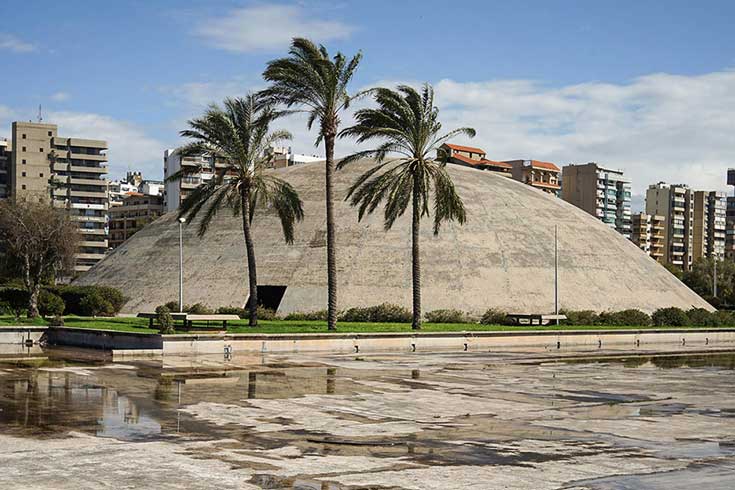
On a humid summer evening, silence hangs over the Rashid Karami International Fair in Tripoli, Lebanon, its cracked concrete structures cooling with the setting sun. Most of the year dog-walkers, joggers, and the occasional couple on a bridal photoshoot are all that disturb the lazy decline of these modern ruins, which, according to local architect Wassim Naghi, could cave in at any moment. Parts already have.
Designed by Oscar Niemeyer, one of the great pioneers of modernist architecture, this was once meant to be a showpiece for Lebanon’s standing in the region, a symbol of the Mediterranean-meets-Middle-East allure of the country’s glittering 1960s heyday. It was destined to outshine all other exhibition centers in the region, drawing an estimated two million visitors a year to the ancient port city of Tripoli.
Had it been completed, the one million square meter site would have been among the largest exhibition centers in the world, putting Tripoli on the map as a hub for trade shows and international events. Of the 18 main structures, Niemeyer’s Experimental Theater stands out, with thick concrete walls moulded into an enormous dome that was once intended to house a performance space featuring a rotating stage. Today, it’s only tourists — and teenagers on skateboards — that come to test the impressive acoustics, which send the slightest sound ringing around in the darkness. Across the park is the helipad, below which Niemeyer planned to build a subterranean space museum, and next to this an open-air theater framed by a tall sound amplifier that’s visible from hilltops around the city.
But like a sorry symbol of Lebanon’s unfulfilled promise after civil war shattered the country and reduced cities to rubble, the site remains abandoned, its concrete arches and bunker-like theater unfinished five decades on. Now, plans to build a business and technology park are set to bring this dilapidated landmark to life while fostering entrepreneurship and innovation in Lebanon’s second city.
“It’s a tremendous space that has never been used as it should be,” said Naghi, who established the Oscar Niemeyer Foundation to shore up the concrete structures, which have become brittle with carbonation in the damp coastal air. It would take around $40 million to make the buildings safe, he said — money that’s not readily available in one of Lebanon’s poorest cities. But with the site under consideration for UNESCO World Heritage status, he hopes outside investment will be more forthcoming.
The area earmarked for the proposed business park, known as the Knowledge and Innovation Centre (KIC) will restore two existing Niemeyer buildings – the customs house and administration office – with the majority built underground in a new 60,000 meter development. Down here, airy offices set around sunken courtyards will house a mix of startups and big-name brands supported by training academies, incubators and accelerator firms alongside banks, food outlets and other services.
The concept mirrors the self-contained style of Dubai Media City and will foreground Tripoli as a tech hub in Lebanon, said Dr Hassan Dennaoui, acting chairman at Tripoli Special Economic Zone (TSEZ), the authority behind the project. “This is the first underground digital city in the Middle East and it feeds into the government’s aim to establish the digital sector as one of Lebanon’s main industries,” he added. Plans for the tech city have got the green light, but as yet there’s no date set for the start of construction.
Tripoli is Lebanon’s landing point for the India-Middle East-Western Europe communications cable and TSEZ hopes to attract global brands like Microsoft and Google alongside local and regional companies. “You have the internet flow, now we can create the technology delta around it,” said Dennaoui.
The design of the new center has been developed with brand visibility in mind. “One of the issues raised by future investors and tenants was how they would showcase themselves in an underground building,” said architect Imad Aoun, whose company mddm Architects beat 110 local and international firms in a competition to design the new site. He and his colleague, architect Nadim Younes, resolved the issue by placing brand logos on top of the buildings at ground level, where they can be incorporated into park benches and other features of the urban environment.
“I like to think Niemeyer would have been satisfied by our design. At the time he was known for his high-tech architecture. Our proposal carries this forward to suit the demands of the digital age,” Aoun said.
In the 1970s, Niemeyer was unhappy with the slow pace of progress as his project became entangled in political interests before war broke out and it was abandoned. Half a century on, part of his park will be given a fresh purpose that’s in keeping with the pioneering spirit of his era-defining designs. “I think he would be happy to see his buildings used to support innovation and benefit the economy,” Naghi said.
For original article, click here



